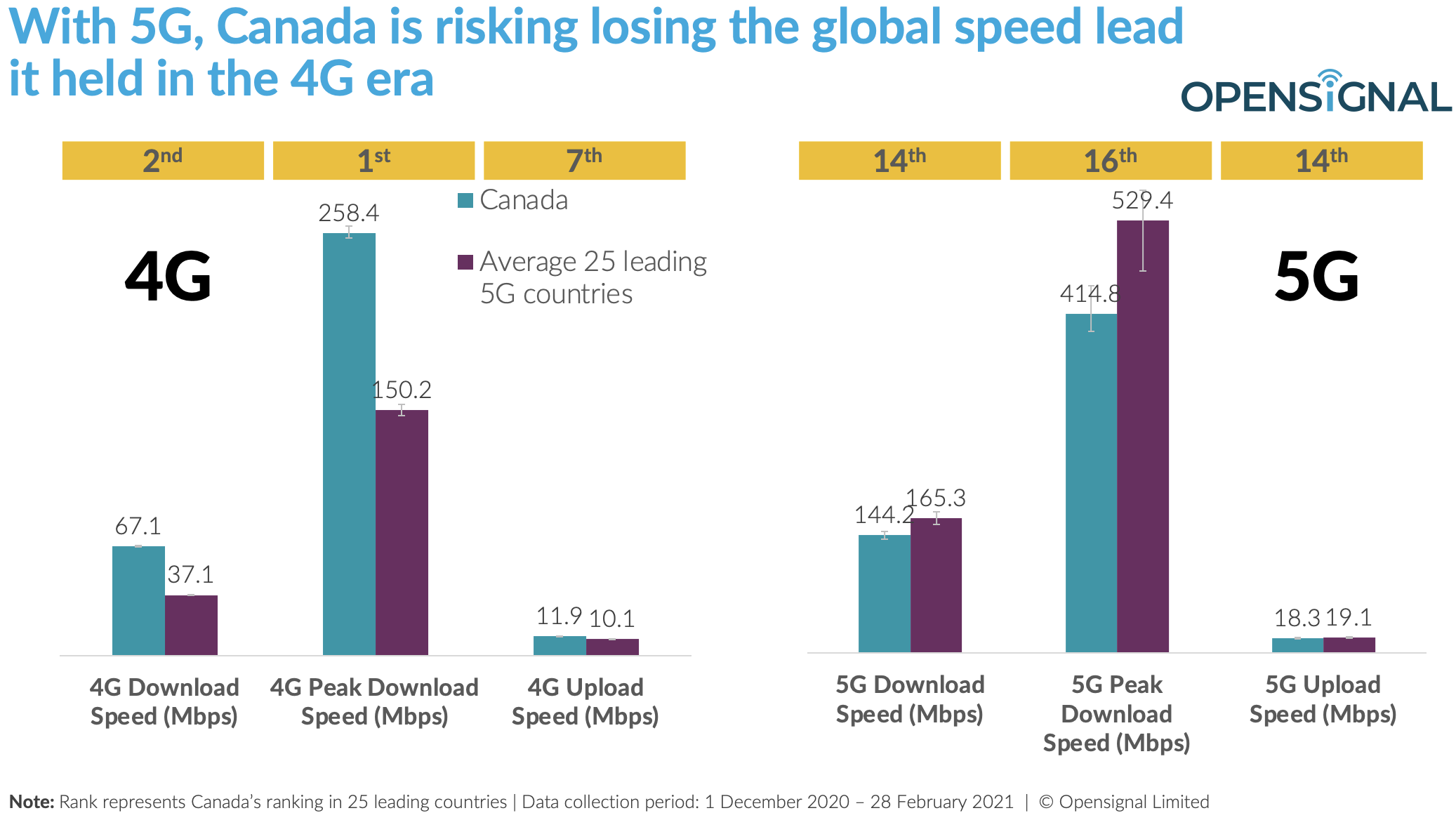In recent years, Canada’s mobile internet users have seen significant improvements to their network experience as operators in the country have consistently invested in new technologies to increase spectrum efficiency and capacity. By virtue of this, Canada has some of the fastest 4G networks in the world, each of the three national operators — Telus, Bell and Rogers — placed in the top ten for Download Speed Experience in our recent global operator analysis. But 5G is more challenging because Canada’s operators have had access to less new 5G wireless spectrum than operators in many other countries. So, how does Canada fare when it comes to its 5G network experience?
To understand this, Opensignal analyzed the real-world 5G experience of our users in Canada in terms of their average download and upload speeds and their experience when streaming mobile video, and compared it against the average 5G experience of our users in 25 leading 5G countries. Along with 5G, we have also analyzed our users’ 3G and 4G mobile experiences and compared the difference across each mobile network technology.
The download speed of our Canadian users, when connected to 4G, averaged a whopping 67.1 Mbps — the second fastest 4G Download Speed among 25 leading 5G countries and 30 Mbps (80.9%) faster than the average download observed by our users in those countries. However, when connected to 5G, our users experienced download speeds just 2.2 times faster than those on 4G. This 4G to 5G uplift is significantly lower than that seen in other mature 4G markets such as South Korea, which in the past was head-to-head with Canada to claim the global leadership position on Download Speed Experience. As a result, Canada’s 5G Download Speed score of 144.2 Mbps ranks 14th — 12.7% or 21.1 Mbps slower than that experienced by our users in the leading 25 5G countries.
When we look at the Peak Download Speed — the average speed experienced by the top 2% of our users — we see an even starker difference between 4G and 5G. While Canada’s 4G Peak Download Speed of 258.4 Mbps was a noteworthy 108.2 Mbps (72.1%) higher than the average peak speed of 25 leading 5G countries (150.2 Mbps), its 5G Peak Download Speed of 414.8 Mbps was significantly 114.6 Mbps (21.6%) slower than the average in those countries.
The trend in Upload Speed was similar to Download Speed. Canadian users experienced average upload speeds of 18.3 Mbps when connected to 5G — 52.9% faster than the 11.9 Mbps seen when connected to 4G. However, while our Canadian users’ 4G Upload Speeds were 1.8 Mbps higher than the average 4G upload speeds seen by our users in 25 leading 5G countries, their 5G Upload Speed was statistically tied with the average score across the 25 countries. These differences in user experience show that with 5G, Canada is risking losing the global speed leadership position it held in the 4G era.

Looking at the experience of our smartphone users when streaming video over mobile connections, we found that our Canadian users enjoyed an Excellent (75 or above) video experience when connected to 5G. In contrast, 4G Video Experience rated Very Good (65-75). An Excellent rating means that there was a very consistent experience across all users, video streaming providers and resolutions tested, with fast loading times and almost non-existent stalling. And as we descend to lower categories, loading times lengthen, and users encounter more stops and stutters in the video stream.
Again we see Canada ranks higher globally for 4G Video Experience than for 5G. The video experience observed by our Canadian users when connected to 5G is 16th among 25 leading 5G countries, while their 4G Video Experience ranks 11th. Our analysis shows that Canadian users continue to benefit from some of the fastest 4G experiences globally, but this is not yet true for 5G. Canada’s leading operators are well into the 5G deployment cycle, but the 4G/5G uplift in Canada’s user experience has been lower than what their peers in other 5G countries have seen.
The difference in Canada’s 4G and 5G international position is likely because Canada’s operators are limited to deploying 5G in lower spectrum bands for now as the auction of the critical 3.5 GHz mid-band spectrum was delayed until June 2021 due to COVID-19. However, even then, Canadian operators will have access in this auction to a very limited amount of spectrum in the 3.5 GHz band — 200 MHz (maximum of 150 MHz for Bell, Telus and Rogers) — which is significantly lower compared to many other 5G countries. The full capabilities of 5G are best realized through the wider channel sizes in the new 5G bands, as the ITU’s minimum technical requirements to meet the IMT-2020 criteria — and thus the fastest speeds — specify at least 100 MHz of spectrum per operator.
In future, Canada’s operators need access to comparable amounts of new 5G spectrum to operators in other countries. Otherwise, if Canada’s operators are forced to continue to rely on re-using existing spectrum for 5G, or lower frequency bands for 5G that offer great coverage but lower capacity, then Canada risks falling behind in the global 5G race for offering the best mobile network experience.
Opensignal Limited retains ownership of this insight including all intellectual property rights, data, content, graphs & analysis. Reports and insights produced by Opensignal Limited may not be quoted, reproduced, distributed, published for any commercial purpose (including use in advertisements or other promotional content) without prior written consent. Journalists are encouraged to quote information included in Opensignal reports and insights provided they include clear source attribution. For more information, contact [email protected].
